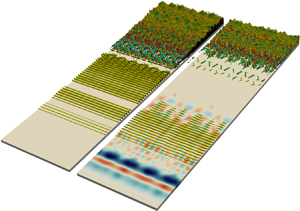Article contents
Optimal heat flux for delaying transition to turbulence in a high-speed boundary layer
Published online by Cambridge University Press: 14 April 2021
Abstract

The optimal steady wall heat flux is sought to delay transition to turbulence in a Mach 4.5 boundary layer, when the free stream disturbance is the nonlinearly most dangerous condition that causes the earliest breakdown to turbulence in the adiabatic flow. The transition-delay strategy is pursued using direct numerical simulations, and the problem is formulated as a constrained optimization where the objective is to minimize the viscous drag force and the control vector is the heat flux at the wall. The optimization is performed using an ensemble-variational approach. The algorithm identifies regions of the flow that are most sensitive to thermal treatment: most of the heating and cooling is applied upstream of the synchronization point of the slow and the fast modes. Attenuation of key instability waves by the optimal heat flux mitigates the nonlinear interactions that preceded breakdown to turbulence in the reference flow, and hence transition is appreciably delayed. Detailed analysis of the acoustic, entropic and solenoidal components of the momentum density vector reveals the stabilizing effects of the optimal heat flux. In addition, the influence of the thermal treatment is not limited to the pretransitional flow where it is concentrated, but rather it persists downstream even within the newly formed fully turbulent boundary layer.
- Type
- JFM Papers
- Information
- Copyright
- © The Author(s), 2021. Published by Cambridge University Press
Footnotes
Current address: Department of Aerospace, Physics and Space Sciences, Florida Institute of Technology, Melbourne, FL 32901, USA.
References
REFERENCES
- 15
- Cited by



